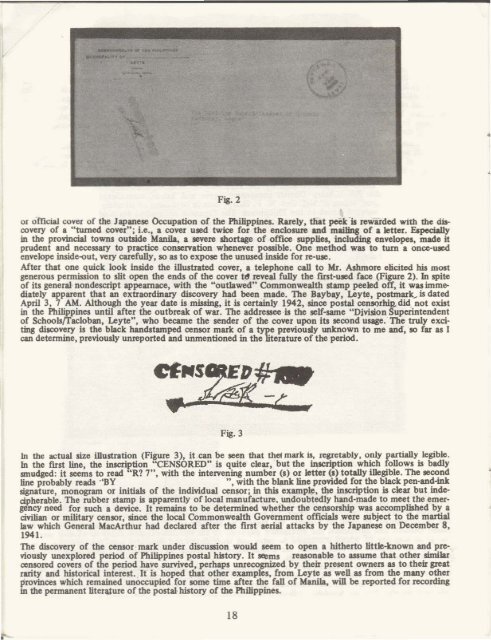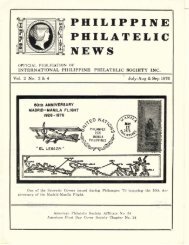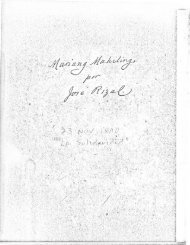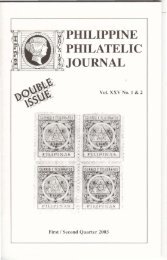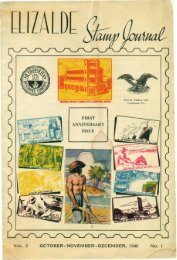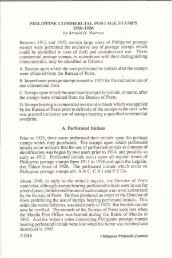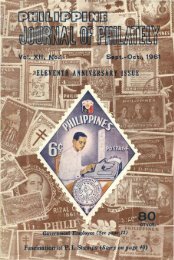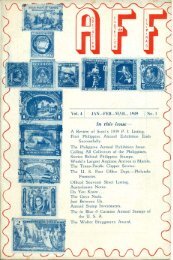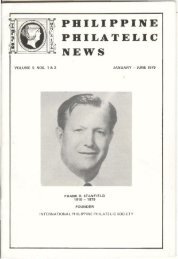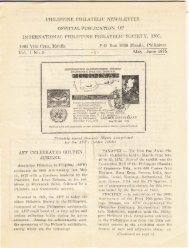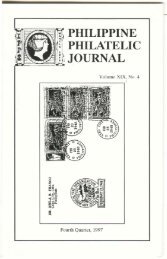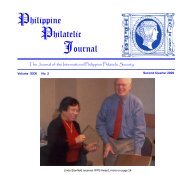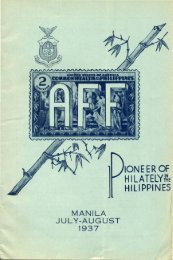April-December 1977, Vol. 3, No.s 2-4 - International Philippine ...
April-December 1977, Vol. 3, No.s 2-4 - International Philippine ...
April-December 1977, Vol. 3, No.s 2-4 - International Philippine ...
You also want an ePaper? Increase the reach of your titles
YUMPU automatically turns print PDFs into web optimized ePapers that Google loves.
Fig. 2<br />
01 olficial cover of the Japanese Occupation of the <strong>Philippine</strong>s. Rarely. that peek-u rewarded with the discovery<br />
of a "turned cover"; Le., a cover used twice for the enclosure and mailing of a letter. Eapccially<br />
in the provincial towns outside Manila. a severe shortage of office supplies, including envelopes, made it<br />
prudent and necessary to practice conservation whenever possible. One method was to tum a once-wed<br />
envelope inside-out. very carefully. so as to expose Ute unused inside for I'll-we.<br />
After that one quick look inside the illustrated cover. a telephone caD to Mr. Ashmore elicited hiJ most<br />
generous pennission to slit open the ends of the cover t4.9 reveal fully the fll'lt-ud face (Figure 2). In spite<br />
of its general nondescript appeamace. with the "outlawed" Commonwealth stamp peeled off, it was imme><br />
diateIy apparent that an extraordinary discovery had been made. The Baybay. Leyte. postmark... is dated<br />
<strong>April</strong> 3. 7 AM. Although the year date is missing, it is certainly 1942, since postal cenSQrhiQ.did_ not exist<br />
in the PhiliE.pines until after the outbreak of war. The addressee is the self-same "Division Superintendent<br />
of Schootsrracloban, Leyte", who became the sender of the cover upon its second usage. The truly exciting<br />
discovery is the black handstamped censor mark of a type previously unknown to me and, 10 far as I<br />
can detennine, previously unreported and unmentioned in the literature of the period.<br />
Fig. 3<br />
m the actual size illustration (Figure 3), it.can be seen that thet mark is, regretably, only partially legible.<br />
In the rust line, the inscrir.tion "CENSORED" is quite clear, but the ~ption which follows is badly<br />
smudged: it seems to read OR 7", with the intervening number (I) or letter (I) totally iDegible. The second<br />
line pIobably ",ad, "BY<br />
", with the blank line pIovided fOI the black pen-and-lnlt<br />
signature, monogram or initials of the individual censor; in this example, the inscription is clear but indecipherable.<br />
The rubber stamp is apparently of local manufacture. undoubtedly hand-made to meet the emergency<br />
need for such a device. It remains to be determined whether the censorship was accomplished by a<br />
civilian or military cenlOr, since the local Commonwealth Government officials were subject to the martial<br />
law which General MacArthur had declared after the rust aerial attacks by the Japanese on <strong>December</strong> 8,<br />
1941.<br />
The discovery of the censor· mark under discussion would seem to open a hitherto littJe-known and previously<br />
unexplored period of <strong>Philippine</strong>s postal history. It seems reuonable to assume that other similar<br />
censored covers of the period have survived, perhaps unrecognized by their present owners u to their great<br />
rarity and historical interest. It is hoped that other examples, from Leyte u weD u from the many other<br />
provinces which remained unoccupied for some time after the fall of Manila, wiD be reported for recording<br />
in the permanent literuure of the postalhistory of the <strong>Philippine</strong>s.<br />
18


